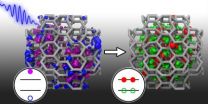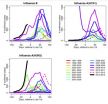(Press-News.org)
Using an exotic form of silicon could substantially improve the efficiency of solar cells, according to computer simulations by researchers at the University of California, Davis, and in Hungary. The work was published Jan. 25 in the journal Physical Review Letters.
Solar cells are based on the photoelectric effect: a photon, or particle of light, hits a silicon crystal and generates a negatively charged electron and a positively charged hole. Collecting those electron-hole pairs generates electric current.
Conventional solar cells generate one electron-hole pair per incoming photon, and have a theoretical maximum efficiency of 33 percent. One exciting new route to improved efficiency is to generate more than one electron-hole pair per photon, said Giulia Galli, professor of chemistry at UC Davis and co-author of the paper.
"This approach is capable of increasing the maximum efficiency to 42 percent, beyond any solar cell available today, which would be a pretty big deal," said lead author Stefan Wippermann, a postdoctoral researcher at UC Davis.
"In fact, there is reason to believe that if parabolic mirrors are used to focus the sunlight on such a new-paradigm solar cell, its efficiency could reach as high as 70 percent," Wippermann said.
Galli said that nanoparticles have a size of nanometers, typically just a few atoms across. Because of their small size, many of their properties are different from bulk materials. In particular, the probability of generating more than one electron-hole pair is much enhanced, driven by an effect called "quantum confinement." Experiments to explore this paradigm are being pursued by researchers at the Los Alamos National Laboratory, the National Renewable Energy Laboratory in Golden, Colo., as well as at UC Davis.
"But with nanoparticles of conventional silicon, the paradigm works only in ultraviolet light," Wippermann said. "This new approach will become useful only when it is demonstrated to work in visible sunlight."
The researchers simulated the behavior of a structure of silicon called silicon BC8, which is formed under high pressure but is stable at normal pressures, much as diamond is a form of carbon formed under high pressure but stable at normal pressures.
The computer simulations were run through the National Energy Research Scientific Supercomputing Center at the Lawrence Berkeley Laboratory, which granted the project 10 million hours of supercomputer time.
The simulations demonstrated that nanoparticles of silicon BC8 indeed generate multiple electron-hole pairs per photon even when exposed to visible light.
"This is more than an academic exercise. A Harvard-MIT paper showed that when normal silicon solar cells are irradiated with laser light, the energy the laser emits may create a local pressure high enough to form BC8 nanocrystals. Thus, laser or chemical pressure treatment of existing solar cells may turn them into these higher-efficiency cells," said co-author Gergely Zimanyi, professor of physics at UC Davis.
INFORMATION:
Other authors of the paper are Marton Voros and Adam Gali at the Budapest University of Technology and Economics, Hungary.
The work was funded by a National Science Foundation Solar Collaborative grant awarded to Zimanyi, Galli and colleagues at UC Davis and UC Santa Cruz in 2011. The project brings together experts in material science, chemistry, computer simulations and statistics to develop new approaches to solar power.
1 in, 2 out: Simulating more efficient solar cells
2013-01-29
ELSE PRESS RELEASES FROM THIS DATE:
Study finds eating deep-fried food is associated with an increased risk of prostate cancer
2013-01-29
SEATTLE – Regular consumption of deep-fried foods such as French fries, fried chicken and doughnuts is associated with an increased risk of prostate cancer, and the effect appears to be slightly stronger with regard to more aggressive forms of the disease, according to a study by investigators at Fred Hutchinson Cancer Research Center.
Corresponding author Janet L. Stanford, Ph.D., and colleagues Marni Stott-Miller, Ph.D., a postdoctoral research fellow and Marian Neuhouser, Ph.D., all of the Hutchinson Center's Public Health Sciences Division, have published their findings ...
Study shows climate change could affect onset and severity of flu seasons
2013-01-29
The American public can expect to add earlier and more severe flu seasons to the fallout from climate change, according to a research study published online Jan. 28 in PLOS Currents: Influenza.
A team of scientists led by Sherry Towers, research professor in the Mathematical, Computational and Modeling Sciences Center at Arizona State University, studied waves of influenza and climate patterns in the U.S. from the 1997-1998 season to the present.
The team's analysis, which used Centers for Disease Control data, indicates a pattern for both A and B strains: warm winters ...
Research: Military women may have higher risk for STIs
2013-01-29
As the number of women in the military increases, so does the need for improved gynecologic care. Military women may be more likely to engage in high-risk sexual practices, be less likely to consistently use barrier contraception, and, therefore, more likely to contract sexually transmitted infections (STIs), according to research recently released by a physician at Women & Infants Hospital of Rhode Island.
Vinita Goyal, MD, MPH, followed up earlier research into the rates of contraception use and unintended pregnancy by today's military women and veterans with her latest ...
USGS-NOAA: Climate change impacts to US coasts threaten public health, safety and economy
2013-01-29
According to a new technical report, the effects of climate change will continue to threaten the health and vitality of U.S. coastal communities' social, economic and natural systems.
The report, Coastal Impacts, Adaptation, and Vulnerabilities: a technical input to the 2013 National Climate Assessment, authored by leading scientists and experts, emphasizes the need for increased coordination and planning to ensure U.S. coastal communities are resilient against the effects of climate change.
The recently released report examines and describes climate change impacts ...
When food porn holds no allure: The science behind satiety
2013-01-29
New research from the University of British Columbia is shedding light on why enticing pictures of food affect us less when we're full.
"We've known that insulin plays a role in telling us we're satiated after eating, but the mechanism by which this happens is unclear," says Stephanie Borgland, an assistant professor in UBC's Dept. of Anesthesiology, Pharmacology and Therapeutics and the study's senior author.
In the new study published online this week in Nature Neuroscience, Borgland and colleagues found that insulin – prompted by a sweetened, high-fat meal – affects ...
Power helps you live the good life by bringing you closer to your true self
2013-01-29
How does being in a position of power at work, with friends, or in a romantic relationship influence well-being? While we might like to believe the stereotype that power leads to unhappiness or loneliness, new research indicates that this stereotype is largely untrue: Being in a position of power may actually make people happier.
Drawing on personality and power research, Yona Kifer of Tel Aviv University in Israel and colleagues hypothesized that holding a position of authority might enhance subjective well-being through an increased feeling of authenticity. The researchers ...
Artificial pancreas: The way of the future for treating type 1 diabetes
2013-01-29
Montréal, January 28, 2013 – IRCM researchers, led by endocrinologist Dr. Rémi Rabasa-Lhoret, were the first to conduct a trial comparing a dual-hormone artificial pancreas with conventional diabetes treatment using an insulin pump and showed improved glucose levels and lower risks of hypoglycemia. Their results, published today in the Canadian Medical Association Journal (CMAJ), can have a great impact on the treatment of type 1 diabetes by accelerating the development of the external artificial pancreas.
The artificial pancreas is an automated system that simulates ...
Why are there redheads? Birds might hold the clues
2013-01-29
Red coloration—historically seen as costly in vertebrates—might represent some physiological benefit after all, according to research published in the journal Physiological and Biochemical Zoology.
Pheomelanin, which is responsible for red hair and freckles in humans and orange and chestnut coloration in other animals, is known to increase the damage to skin cells and melanoma risk when present in large amounts. Furthermore, its creation involves the consumption of glutathione, a beneficial antioxidant.
In an attempt to unearth the factors favoring the evolution of ...
AGU Journal Highlights -- Jan. 28, 2013
2013-01-29
The following highlights summarize research papers that have been recently published in Geophysical Research Letters (GRL), Water Resources Research, Journal of Geophysical Research – Planets (JGR-E), Journal of Geophysical Research – Oceans (JGR-C), and Journal of Geophysical Research-Biogeosciences (JGR-G).
In this release:
1. Io's volcanism controls Jupiter's magnetospheric activity
2. Projected U.S. water use likely to increase as climate warms
3. Mercury's crust likely made of magnesium-rich basalt
4. Assessing the Great Whirl, despite all the pirates
5. Tracing ...
Bioinspired fibers change color when stretched
2013-01-29
Cambridge, Mass. – January 28, 2013 - A team of materials scientists at Harvard University and the University of Exeter, UK, have invented a new fiber that changes color when stretched. Inspired by nature, the researchers identified and replicated the unique structural elements that create the bright iridescent blue color of a tropical plant's fruit.
The multilayered fiber, described today in the journal Advanced Materials, could lend itself to the creation of smart fabrics that visibly react to heat or pressure.
"Our new fiber is based on a structure we found in nature, ...


